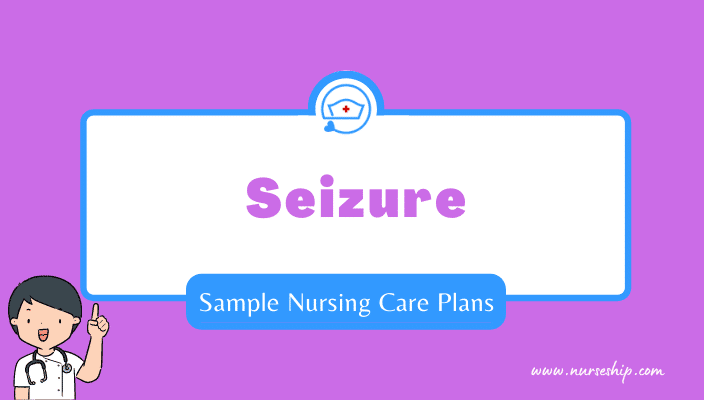Here we will formulate a sample Acute Substance Withdrawal nursing care plan based on a hypothetical case scenario.
It will include three sample nursing care plans with NANDA nursing diagnoses, nursing assessment, expected outcome, and nursing interventions with rationales.
Acute Substance Withdrawal Case Scenario
A 36-year old male patient presents to the ED with complaints of nausea, vomiting, headache, tremors, and anxiety. The patient has a past medical history of alcohol abuse and seizures. The patient reports drinking 8-10 beers every day for the last several years, and their last drink was 12 hours ago. Prior to the hospital, the patient was detoxing at a rehab clinic because he expressed a desire to quit drinking. When the patient started to get hypertensive and confused, the clinic sent him to the hospital.
Upon assessment, the patient is diaphoretic and restless. The patient is oriented to person and place, but is disoriented regarding the time and situation. The patient also complains of seeing ants on the ceiling, confirming the presence of visual hallucinations. The patient denies any auditory hallucinations. The patient’s temperature is 38 C, heart rate is 112 BPM, blood pressure is 172/94 mmHg, respirations are 30 breaths per minute, and oxygen saturation is 99% on room air.
The blood work reveals an elevated AST and ALT of 42 unit/L and 59 unit/L respectively. The nurse performs a CIWA assessment and the patient has a score of 18, indicating severe withdrawal with impending probable delirium tremens.
The patient is admitted to the hospital for Acute Substance Withdrawal.
#1 Sample Acute Substance Withdrawal Nursing Care Plan – Risk for injury
Nursing Assessment
Subjective Data:
- The patient complains of nausea, vomiting, headache, and anxiety
Objective Data:
- The patient is restless and confused
- The patient has a history of seizures
- CIWA score of 18, confirming severe withdrawal
- The patient has elevated liver enzymes
Nursing Diagnosis
Risk for injury related to central nervous system excitability secondary to alcohol withdrawal as evidenced by anxiety, confusion, and severe withdrawal symptoms
Goal/Desired Outcome
Short-term goal: For the duration of the shift the patient will remain safe and free from seizures
Long-term goal: The patient will experience no long-term organ dysfunction as a side effect of alcohol withdrawal or abuse
Acute Substance Withdrawal Nursing Interventions with Rationales – Risk for injury
| Nursing Interventions | Rationales |
| Monitor for seizures and enact appropriate safety interventions | Seizures are common in patients experiencing alcohol withdrawal. Seizure precautions should be taken for patients at high risk, including padding side rails and maintaining the bed in a low position |
| Perform a fall risk evaluation and enact appropriate safety interventions | Withdrawing patients are at a high risk for falls, particularly when accompanied by confusion and disorientation. Bed alarms, hourly rounding, frequent reorienting, and assistance with ambulation are all strategies to avoid falls |
| Provide seclusion and restraints as needed | Patients exhibiting signs of violence towards themselves or others may benefit from seclusion or restraints. While restraints could potentially contribute to increased agitation, they may also be necessary to prevent harm |
| Monitor labs | Electrolyte imbalances are quite common in the withdrawing patient and can lead to organ dysfunction if not corrected. Liver enzymes, kidney function, and glucose levels should also be closely monitored |
#2 Sample Acute Substance Withdrawal Nursing Care Plan – Anxiety
Nursing Assessment
Subjective Data:
- The patient reports feelings of anxiety
Objective Data:
- The patient is restless and experiencing hallucinations
Nursing Diagnosis
Anxiety related to cessation of alcohol as evidenced by anxiety and restlessness
Goal/Desired Outcome
Short-term goal: The patient will report an improvement in anxiety by the end of the shift
Long-term goal: The patient’s anxiety will return to a manageable level and they will experience a sense of having control over their life
Acute Substance Withdrawal Nursing Interventions with Rationales – Anxiety
| Nursing Interventions | Rationales |
| Administer benzodiazepines if needed | These drugs depress the central nervous system and help with anxiety and withdrawal symptoms. Examples include diazepam (Valium) and lorazepam (Ativan) |
| Administer barbiturates if needed | Some patients have better control of symptoms with barbiturates such as phenobarbital (Luminal). While these drugs may also lessen the risk of seizures, they can also lead to greater respiratory depression. |
| Maintain a calm environment | A calm environment with minimal stimulation can ease feelings of anxiety |
| Keep the patient informed on the plan of care | Explanations and a sense of involvement can ease anxiety, enhance trust, and provide the patient with a sense of control |
| Perform CIWA every hour or less frequently as needed to assess the need for more medication | Often patients have a CIWA score-based sliding scale to guide the administration of barbiturates |
#3 Sample Acute Substance Withdrawal Nursing Care Plan – Risk for decreased cardiac output
Nursing Assessment
Subjective Data:
- The patient reports drinking 8-10 beers daily
Objective Data:
- The patient is hypertensive and tachycardic
- The patient’s liver enzymes are elevated
Nursing Diagnosis
Risk for decreased cardiac output related to heart damage secondary to alcoholism as evidenced by hypertension and tachycardia
Goal/Desired Outcome
Short-term goal: The patient’s heart rate and blood pressure will return to normal by the end of the shift.
Long-term goal: No long-term structural damage of the heart will be seen and the patient will resume normal activity
Acute Substance Withdrawal Nursing Interventions with Rationales – Risk for decreased cardiac output
| Nursing Interventions | Rationales |
| Monitor vital signs, particularly heart rate and blood pressure | Tachycardia and hypertension are common in the acute withdrawal phase due to catecholamine release. Hypotension can also occur, especially as a side effect of medication administration |
| Monitor for dysrhythmias | Long-term alcohol use and electrolyte imbalances can cause dysrhythmias |
| Monitor respiratory status and administer oxygen as needed | It’s particularly important to monitor the patient’s respiratory status since benzodiazepines and barbiturates can lead to respiratory depression. The patient may require oxygen or in some cases, intubation |
| Anticipate administration of electrolytes or a “banana bag” | A “banana bag” is a bag of fluid commonly given to alcoholic patients that has vitamins and minerals added, giving it a yellow color (hence the word “banana”). Instead of a banana bag, some institutions will supplement vitamins individually, most commonly folate, thiamine, and magnesium |
| Monitor for symptoms of cardiomyopathy or heart failure | Alcoholic cardiomyopathy is a type of structural heart damage caused by long-term heavy drinking. Symptoms include coughing, edema, and difficulty breathing, particularly when lying down |
Conclusion
To conclude, we created scenario-based three sample nursing care plans for Acute Substance Withdrawal. These nursing care plans include nursing assessment, NANDA nursing diagnosis, expected outcome, and nursing interventions with rationales.
Reference
Ackley, B., Ladwig, G., Makic, M., Martinez-Kratz, M., & Zanotti, M. (2020). Nursing Diagnoses Handbook: An Evidence-based Guide to Planning Care (12th ed.). Elsevier.
Herdman, T., Kamitsuru, S. & Lopes, C. (2021). NURSING DIAGNOSES: Definitions and Classifications 2021-2023 (12th ed.). Thieme.
Swearingen, P. (2016). ALL-IN-ONE CARE PLANNING RESOURCE (4th ed.). Elsevier/Mosby.




